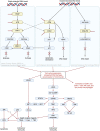Anti-cancer immune responses to DNA damage response inhibitors: Molecular mechanisms and progress toward clinical translation
- PMID: 36276148
- PMCID: PMC9583871
- DOI: 10.3389/fonc.2022.998388
Anti-cancer immune responses to DNA damage response inhibitors: Molecular mechanisms and progress toward clinical translation
Abstract
DNA damage response inhibitors are widely used anti-cancer agents that have potent activity against tumor cells with deficiencies in various DNA damage response proteins such as BRCA1/2. Inhibition of other proteins in this pathway including PARP, DNA-PK, WEE1, CHK1/2, ATR, or ATM can sensitize cancer cells to radiotherapy and chemotherapy, and such combinations are currently being tested in clinical trials for treatment of many malignancies including breast, ovarian, rectal, and lung cancer. Unrepaired DNA damage induced by DNA damage response inhibitors alone or in combination with radio- or chemotherapy has a direct cytotoxic effect on cancer cells and can also engage anti-cancer innate and adaptive immune responses. DNA damage-induced immune stimulation occurs by a variety of mechanisms including by the cGAS/STING pathway, STAT1 and downstream TRAIL pathway activation, and direct immune cell activation. Whether or not the relative contribution of these mechanisms varies after treatment with different DNA damage response inhibitors or across cancers with different genetic aberrations in DNA damage response enzymes is not well-characterized, limiting the design of optimal combinations with radio- and chemotherapy. Here, we review how the inhibition of key DNA damage response enzymes including PARP, DNA-PK, WEE1, CHK1/2, ATR, and ATM induces innate and adaptive immune responses alone or in combination with radiotherapy, chemotherapy, and/or immunotherapy. We also discuss current progress in the clinical translation of immunostimulatory DNA-damaging treatment regimens and necessary future directions to optimize the immune-sensitizing potential of DNA damage response inhibitors.
Keywords: ATM; ATR; CHK1/2; DNA damage response (DDR); DNA-PK; WEE1; cGAS/STING; immunotherapy.
Copyright © 2022 Carlsen and El-Deiry.
Conflict of interest statement
The authors declare that the research was conducted in the absence of any commercial or financial relationships that could be construed as a potential conflict of interest.
Figures

Similar articles
-
Targeting DNA damage response pathways to activate the STING innate immune signaling pathway in human cancer cells.FEBS J. 2021 Aug;288(15):4507-4540. doi: 10.1111/febs.15747. Epub 2021 Feb 18. FEBS J. 2021. PMID: 33529438
-
Triple kill: DDR inhibitors, radiotherapy and immunotherapy leave cancer cells with no escape.Acta Biochim Biophys Sin (Shanghai). 2022 Oct 25;54(11):1569-1576. doi: 10.3724/abbs.2022153. Acta Biochim Biophys Sin (Shanghai). 2022. PMID: 36305726 Free PMC article. Review.
-
The DNA Damaging Revolution: PARP Inhibitors and Beyond.Am Soc Clin Oncol Educ Book. 2019 Jan;39:185-195. doi: 10.1200/EDBK_238473. Epub 2019 May 17. Am Soc Clin Oncol Educ Book. 2019. PMID: 31099635 Review.
-
Enhancing anti-tumour innate immunity by targeting the DNA damage response and pattern recognition receptors in combination with radiotherapy.Front Oncol. 2022 Aug 29;12:971959. doi: 10.3389/fonc.2022.971959. eCollection 2022. Front Oncol. 2022. PMID: 36106115 Free PMC article. Review.
-
Advancing cancer therapy: new frontiers in targeting DNA damage response.Front Pharmacol. 2024 Sep 20;15:1474337. doi: 10.3389/fphar.2024.1474337. eCollection 2024. Front Pharmacol. 2024. PMID: 39372203 Free PMC article. Review.
Cited by
-
Understanding Cancer's Defense against Topoisomerase-Active Drugs: A Comprehensive Review.Cancers (Basel). 2024 Feb 6;16(4):680. doi: 10.3390/cancers16040680. Cancers (Basel). 2024. PMID: 38398072 Free PMC article. Review.
-
HDAC7 induction combined with standard-of-care chemotherapy provides a therapeutic advantage in t(4;11) infant B-cell acute lymphoblastic leukemia.Biomark Res. 2025 Jul 28;13(1):99. doi: 10.1186/s40364-025-00810-1. Biomark Res. 2025. PMID: 40722046 Free PMC article.
-
The mechanism and clinical application of DNA damage repair inhibitors combined with immune checkpoint inhibitors in the treatment of urologic cancer.Front Cell Dev Biol. 2023 May 25;11:1200466. doi: 10.3389/fcell.2023.1200466. eCollection 2023. Front Cell Dev Biol. 2023. PMID: 37305685 Free PMC article. Review.
-
KRTA6A and FA2H Are Hub Genes Associated With Cgas-STING-related Immunogenic Cell Death in Lung Adenocarcinoma.Cancer Genomics Proteomics. 2023 Sep-Oct;20(5):476-486. doi: 10.21873/cgp.20399. Cancer Genomics Proteomics. 2023. PMID: 37643778 Free PMC article.
-
mTORC2 promotes pancreatic cancer progression and parp inhibitor resistance.Oncol Res. 2023 Jun 27;31(4):495-503. doi: 10.32604/or.2023.029309. eCollection 2023. Oncol Res. 2023. PMID: 37415733 Free PMC article.
References
Publication types
LinkOut - more resources
Full Text Sources
Research Materials
Miscellaneous

